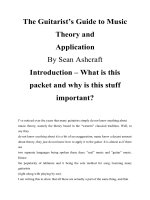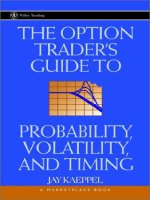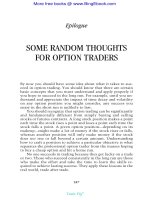The option trader guide to probability volatility and timing
Bạn đang xem bản rút gọn của tài liệu. Xem và tải ngay bản đầy đủ của tài liệu tại đây (3.07 MB, 286 trang )
TE
AM
FL
Y
THE OPTION TRADER’S
GUIDE TO PROBABILITY,
VOLATILITY, AND TIMING
Team-Fly®
Founded in 1807, John Wiley & Sons is the oldest independent
publishing company in the United States. With offices in North
America, Europe, Australia, and Asia, Wiley is globally committed to developing and marketing print and electronic products
and services for our customers’ professional and personal knowledge and understanding.
The Wiley Trading Series features books by traders who have
been able to work with the market’s ever changing temperament
and prosper—some by reinventing systems, others by getting
back to basics. For the novice trader, professional, or somewhere
in between, these books will provide the advice and strategies
needed to prosper today and well into the future.
For a list of available titles, please visit our Web site at
www.WileyFinance.com.
A Marketplace Book
THE OPTION TRADER’S
GUIDE TO PROBABILITY,
VOLATILITY, AND TIMING
Jay Kaeppel
John Wiley & Sons, Inc.
Copyright © 2002 by Jay Kaeppel. All rights reserved.
Published by John Wiley & Sons, Inc., New York.
Published simultaneously in Canada.
No part of this publication may be reproduced, stored in a retrieval system,
or transmitted in any form or by any means, electronic, mechanical,
photocopying, recording, scanning, or otherwise, except as permitted under
Section 107 or 108 of the 1976 United States Copyright Act, without either
the prior written permission of the Publisher or authorization through
payment of the appropriate per-copy fee to the Copyright Clearance Center,
222 Rosewood Drive, Danvers, MA 01923, (978) 750-8400, fax (978) 750-4744.
Requests to the Publisher for permission should be addressed to the
Permissions Department, John Wiley & Sons, Inc., 605 Third Avenue, New
York, NY 10158-0012, (212) 850-6011, fax (212) 850-6008, e-mail:
This publication is designed to provide accurate and authoritative
information in regard to the subject matter covered. It is sold with
the understanding that the publisher is not engaged in rendering professional
services. If professional advice or other expert assistance is required, the
services of a competent professional person should be sought.
Wiley also publishes its books in a variety of electronic formats. Some
content that appears in print may not be available in electronic books. For
more information about Wiley products visit our Web site at
www.wiley.com.
ISBN: 0-471-22619-X
Printed in the United States of America.
10 9 8 7 6 5 4 3 2 1
In loving memory of Arthur H. Kaeppel
Contents
Chapter 1
1
Introduction
Who Can Benefit from This Book
1
What Sets This Book Apart
2
Can Options Really Be Simplified?
2
What This Book Provides
2
Overview of Option Trading
3
Understanding Risk by Using Risk Curves
Asking the Right Question
9
Analyzing Risk: What Separates the Winners
from the Losers
11
Summary
18
Chapter 2
21
The Basics of Options
Option Definitions
21
Options on a Specific Security
26
Intrinsic Value versus Extrinsic Value
In-the-Money versus Out-of-theMoney Options
32
Summary
35
Chapter 3
6
30
Reasons to Trade Options
The Three Primary Uses of Options
37
Leveraging an Opinion on Market Direction
vii
37
39
viii
Contents
Hedging an Existing Position (and
Generating Income)
41
Taking Advantage of Neutral Situations
Summary
46
Chapter 4
47
Option Pricing
Theoretical Value
47
Examples of Theoretical Option Pricing
Overvalued Options versus Undervalued
Options
50
Summary: Theory versus Reality
52
Chapter 5
44
Time Decay
49
55
The Effect of Time Decay on the Price of
an Option
56
Implications of Time Decay
58
Time Decay Illustrated
58
Summary
62
Chapter 6
Volatility
Volatility: The Most Important Concept in
Option Trading
63
Historic Volatility Explained
63
Implied Volatility Explained
65
Is Implied Volatility High or Low? Relative
Volatility Explained
69
Relative Volatility Ranking
72
Considerations in Selecting OptionTrading Strategies
72
Why Does Volatility Matter?
74
The Effect of Changes in Volatility
77
Summary
80
63
Contents
Chapter 7
ix
81
Probability
Weighing the Pros and Cons
81
Strategies for a Bullish Scenario
82
Profit/Loss Comparisons
86
Delta
89
Probability Analysis
91
The Correct and Incorrect Ways to
Use Probability
95
Summary
96
Chapter 8
99
Market Timing
The Underlying Security Is Expected to Move
within a Specific Period
100
The Underlying Is Expected to Move in a
Particular Direction but Not in a
Specific Time Frame
102
The Underlying Is Expected to Move Significantly
but the Direction Is Unknown
103
The Underlying Is Expected to Stay within a
Range or Not Move Much in Any
Direction
105
Summary
106
Chapter 9
107
Trading Realities
Exercise and Assignment
107
Bid and Ask Prices and the Importance of
Option Volume
110
Appreciating the Effect of Bid-Ask Spreads
Factors in Dealing with Bid-Ask Spreads
A Word on Limit Orders
113
Summary
115
Chapter 10
117
Important Concepts to Remember
Valid Reasons to Trade Options
Option Pricing
118
111
113
117
x
Contents
Time Decay
118
Volatility
119
Probability
120
Market Timing
120
How to Lose Money Trading Options
The Keys to Success in Option Trading
Summary
128
Chapter 11
139
148
151
Buy a Backspread
Key Factors
151
Position Taken
157
Backspreads versus Naked Calls and Puts
Volatility and Backspreads
159
Position Management
162
Trade Result
164
Chapter 14
133
Buy a Naked Option
Key Factors
139
Position Taken
146
Position Management
Trade Result
150
Chapter 13
131
Overview of Trading Strategy Guides
The Two Key Elements in Selecting a
Trading Strategy
131
Trading Strategy Matrix
133
Overview of Trading Strategy Chapters
Chapter 12
121
125
165
Buy a Calendar Spread
Key Factors
165
Position Taken
173
Position Management
Trade Result
174
157
173
Contents
xi
A Decline in Volatility Is Deadly to
Calendar Spreads
175
Chapter 15
179
Buy a Straddle
Chapter 16
Sell a Vertical Spread
191
199
TE
Key Factors
191
Position Taken
197
Position Management
Trade Result
200
Chapter 17
188
AM
FL
Y
Key Factors
179
Position Taken
186
Position Management
Trade Result
190
201
Write a Covered Call
211
Sell a Naked Put
Key Factors
201
Position Taken
206
One Method for Managing Stock Position
If Assigned
208
Position Management
209
Trade Result
209
Chapter 18
Key Factors
211
Position Taken
216
Position Management
218
Trade Result
219
Writing Covered Calls without Limiting
Upside Potential
220
Team-Fly®
xii
Chapter 19
Contents
Key Factors
223
Position Taken
229
Position Management
Trade Result
235
Chapter 20
223
Enter a Butterfly Spread
233
237
Placing Trades
Considerations in Placing Option Orders
238
Placing Orders by Phone and On Line
238
Summary
246
Epilogue
Some Random Thoughts for Option Traders
247
Appendix A
PROVEST Option Trading Method Criteria
251
The PROVEST Option Trading Method: A
Framework for Trade Selection
251
Appendix B
Option Exchanges, Option Brokers, Option
Symbols, and Option Volume
Exchanges
255
Brokerage Firms
257
Resources
257
Stock and Stock Index Option Symbols
Stock Option Volume Statistics
258
Index
255
258
265
Foreword
Novice traders are attracted to the options market because of the
degree of leverage and the vision of enhanced profitability it affords them. Options, however, are unlike any other exchangetraded product because of leverage, and more importantly,
because of an attribute referred to as time decay. Unfortunately,
traders learn the hard way that many factors besides calling the
market direction correctly come into play in trading options.
Most traders do not understand implied volatility, time decay,
and out-of-the-money versus in-the-money options. Many do not
have a working knowledge of which option strategies are best for
any given situation, and they fail to understand just what the
risk is before they make their trades.
Jay Kaeppel explains these issues in The Option Trader’s
Guide to Probability, Volatility, and Timing. Kaeppel covers the
basics and then goes on to teach how to trade options. And
he doesn’t do it with get-rich-quick examples and hyperbole. He
looks at the options market with a thorough analysis of both
the risk and the profit potential of the various strategies, and he
does so in a very readable fashion.
Kaeppel outlines the steps involved in becoming a successful
trader. He explains the different strategies available and when to
use each one. He shows how to accurately assess volatility and
from there, how to profit by disparities in the implied volatilities
of different options. His strategies include guidelines for determining when to buy undervalued options and when to sell overvalued options. Finally, Kaeppel teaches when to take a profit,
and most importantly, when to cut losses and move on to the
next trade.
xiii
xiv
Foreword
The key value of this book is its objectivity and its details.
The guidelines are clear and objective, not a collection of anecdotal examples that have happened once or twice. Save yourself
some money and benefit from this money manager’s experience
and wisdom if you want to profit in the options market.
THOM HARTLE
2001
Thom Hartle (www.thomhartle.com) is a trader and educator
working with private trades, as well as a contributing editor for
Active Trader Magazine.
Chapter 1
INTRODUCTION
Who Can Benefit from This Book
This book is written for people who fall into one of two
categories:
1. Those who are new to option trading and looking for a good
place to start
2. Those who have traded options in the past and did not
achieve the type of success they had hoped to
Option trading enjoyed explosive growth during the late
1990s and into the start of the new millennium, particularly
among individuals. Traders whose bankrolls were fattened by
the great bull market in stocks fueled part of this growth. Having
enjoyed great success in the stock market, many people decided
to try to increase their gains by accessing the leverage associated
with options. Along the way computers got faster and more
powerful, technology advanced rapidly, and markets traded with
greater volume and volatility than ever before. Yet there is much
about option trading that is no different than it ever was.
Through all the years and all the growth and changes, critical elements remain that traders must understand and apply consistently if they hope to succeed in the long run. The purpose of
this book is to illuminate these concepts and show how to apply
them successfully in real-world trading.
1
2
The Option Trader’s Guide
What Sets This Book Apart
The primary focus of this book is not to teach you about options,
but rather to teach you how to successfully trade options. Having
a textbook understanding of any topic is not the same thing as applying that knowledge in the real world. This book is intended to
give new traders and returnees to the options market an understanding of what it takes to succeed, as well as a set of guidelines
to apply in the real world of trading. Most of all, it is intended to
make traders aware of the sobering realities of option trading, including the financial risks involved. No attempt is made to
candy-coat the fact that garnering consistent profits in the options market over a long period is a difficult goal to achieve.
Can Options Really Be Simplified?
Options are by nature fairly complex. Not only are there many
trading strategies to consider, there also are many different factors that apply to trade selection and position management. To
complicate things even further, some factors matter a lot with
certain strategies and not as much with others. Nevertheless,
despite the inherent complexities, it is possible to gain an understanding of these key factors without a Ph.D. in finance. This
book will introduce you to the most important basic concepts
in option trading and illustrate why an understanding of these
concepts is critical to your long-term success. In the later chapters of this book, the concepts are applied to a number of different trading strategies to show you how to get the most out of
each situation.
What This Book Provides
A careful reading of the material in this book will give you the
following:
• An introduction to the most valuable uses of options
• Basic option terminology
Introduction
3
• Explanations of the most important concepts in option
trading
• Explanations of the most useful trading strategies available
• The conditions to look for when deciding which strategy to
employ
• Objective guidelines for employing each strategy
• Objective guidelines for exiting a trade at a loss
• Objective guidelines for exiting a trade at a profit
Overview of Option Trading
Most option traders use options simply as a tool to leverage their
market-timing decisions. They buy call options when they think
an advance is imminent and they buy put options when they
think a decline is forthcoming. Unfortunately, because buying
calls and puts involves buying a wasting asset, in most cases
this approach ends up being unprofitable. It is estimated that
90% or more of people who trade options lose money in the long
run. If this is true, it is a staggering number. However, a high
failure rate is not all that surprising when you consider the complexity involved in trading options and the fact that most option
traders do not take the time to develop a well-thought-out plan
before they begin trading. In addition, many traders are poorly
prepared to deal with the emotional aspects of trading.
It is vitally important to your long-term success that you
use a structured approach to trading.
This is not to imply that your trading approach must be completely systematic. What it means is that you must establish and
follow some reasonably well-thought-out guidelines if you hope
to achieve consistent success. Markets can turn on a dime. If you
do not have a well-thought-out trading plan, you will find yourself chasing each twist and turn of the market. In addition, if you
do not develop the discipline to follow your trading plan, the
odds are overwhelming that you will join the 90% of traders who
lose money.
4
The Option Trader’s Guide
To go one step further, not only should you have a plan before you start trading, you must plan each option trade in terms
of how you will manage each position once you have entered
into it. There is no one best trading strategy; each one has
strengths and weaknesses. By examining the best-case and
worst-case scenarios for each trade, you can establish objective
criteria for when to exit each trade, whether you are taking a
profit or cutting a loss.
Too many traders enter the markets on a whim, without
carefully considering either
• The likelihood that they will be successful in the long run
• The potential pitfalls they may encounter and what they can
do to avoid them
The material in this book is written to help you as a trader by
providing a specific trading plan, using well-thought-out and
market-tested criteria for entering and exiting each trade. It is
also intended to help you hone your ability to think like a trader
by walking you through example trades to let you develop a feel
for the process of deciding on
• Strategy selection
• Individual trade selection
• Position-management guidelines
Each strategy chapter in this book (Chapters 12 through 19)
delineates a specific set of rules for each strategy. Be assured that
there is no intent to convince you that this is the only way to use
a given strategy. The underlying point is my belief that traders
are better off in the long run if they adopt one approach they are
comfortable with for a given strategy than if they make it up as
they go along, using one approach one time and a different approach the next time.
The Benefits of an Objective Approach
Traders gain a psychological benefit from doing their best thinking
up front and building a well-thought-out trading plan. After that,
Introduction
5
they are simply following the rules. One thing to remember is
that your trading plan will not always maximize your profit on
each and every trade. This is simply a reality of trading. The benefits of using an objective approach to option trading include these:
• Eliminating emotional decision making
• Relieving the psychological burden of being right or wrong in
each situation
• Doing your best thinking up front and then trusting in your
plan, rather than having to make subjective decisions in the
heat of battle
Constructing a well-thought-out trading plan is a crucial step
toward consistent trading success. A trading plan relieves a great
deal of the emotional pressure that traders feel when they rely on
gut instinct and hunches to trade. Too many traders assume that
they will know the right thing to do when the time arrives. In reality, more often than not this turns out to be exactly the opposite of what actually occurs. In a bad situation, with real money
on the line, unprepared traders make emotional decisions based
solely on fear or greed. Very often these are decisions that they
would never make if they were thinking rationally.
The good news about developing a trading plan is that a wellthought-out plan can serve as a road map to trading profits by
keeping you from overreacting to every bend in the road. The bad
news is that no approach to trading is perfect. There are no magic
formulas or holy grail for trading.
The surest way to succeed as a trader is to develop a trading approach that has a realistic probability of making
money in the long run and then to stick to your plan.
Here are the key steps in this process.
1. Identify criteria that give you the greatest probability of success in the long run.
2. Develop confidence in the approach you are using. Confidence comes from establishing criteria that cover all the following bases:
6
The Option Trader’s Guide
•
•
•
•
When to use a particular strategy
When to enter a trade
When to exit a trade at a profit
When to exit a trade at a loss
3. Develop the discipline to stick to your approach even when
things are not going well. This comes from having the confidence developed in Step 2.
Once you reach this point, your trading process becomes second
nature. Through good times and bad you continue to trade consistently, confident that in the long run you will come out ahead.
This is a trait of all successful traders.
Understanding Risk by Using Risk Curves
A risk curve is a graph that depicts the profit or loss characteristics for a given option trade. Analyzing a risk curve allows a
trader to visualize the market action needed to make money on
that particular trade. Such a graph is also useful in assessing
• Break-even points and probability of profit
• Maximum risk
• Profit potential
Additionally, two or more risk curves can be analyzed to determine which trade offers the reward-to-risk characteristics a
trader deems most attractive.
More than anything, a risk curve is a forest-from-the-trees
tool. For any option trade, it does not really matter in the end
what the position is—whether it is long a call, long a spread,
short a spread, or any other combination. In the final analysis the
only questions that matter are these:
• What has to happen in order for me to make money on this
trade?
• What is my worst-case scenario?
A risk curve allows you to visualize the answer to these allimportant questions. Risk curves are used throughout this book
Introduction
7
1325
Date:
Profit/Loss:
Underlying:
Above:
Below:
% Move Required:
883
442
2/16/01
–10
98.22
39%
61%
+4.2%
0
–442
–1325
79.00
84.00
AM
FL
Y
–883
89.00
94.00
99.00
104.00
109.00
Figure 1.1 Risk curves for IBM February 85 call option (from 79 to 109).
TE
to depict the profit and loss characteristics of various trades. Let’s
look at an example to help you understand what these graphs
show and why the information they contain is so important.
Figure 1.1 shows risk curves for a position that involves buying the IBM February 85 call option on January 5 at a price of
13.25 ($1325). A range of prices for the stock is listed along the
bottom of the graph, with the current price of 94 in the middle.
The graph shows the profitability of this trade based on an underlying stock price ranging from 79 to 104. The actual expected
dollar profit or loss is listed on the left side of the graph.
Each curve on the graph displays the expected profit or loss at
a given stock price as of a given date. This trade was initiated on
January 5. The top curve shows the expected return as of January
12, the next curve as of January 19, then January 26, February 2,
February 9, and finally, the date of the February option expiration, which is February 16. Much useful information may be
gleaned from this graph.
The Effect of Time Decay
The first thing to note is the effect of time decay. As we discuss
in detail in Chapter 5, time decay refers to the erosion of an
Team-Fly®
8
The Option Trader’s Guide
option price as time passes and option expiration draws nearer.
The obvious implication from this graph is that the buyer of this
option stands to earn a greater profit if the price of the stock
rises sooner rather than later. As the price of the option erodes
slightly with each passing day due to time decay, a larger price
move by the underlying security is required to offset this loss.
Break-Even Analysis and Probability of Profit
The lowest curve on the graph in Figure 1.1 displays the expected profit or loss if the option is held until expiration. Although many options are exited before expiration, it is often
helpful to know where a trade is going to end up eventually if the
trader does nothing before expiration. In this case the break-even
point is 98.25 (which equals the strike price of 85 plus the price
paid for the option of 13.25). Based on the volatility of IBM stock
when this trade is entered, there is a 39% probability that IBM
will rise from 94 to 98.25 or higher by the time of February option expiration. This probability value is most useful when compared to the probability value for another potential trade. By
comparing two or more trades, a trader can determine which is
most likely to generate a profit.
Maximum Risk
Whenever you buy an option, your risk is limited to whatever
price you paid to buy the option. In this example the buyer paid
$1325 to buy the option. You can see by the lowest curve on the
graph in Figure 1.1 that the maximum loss will occur if the stock
is trading at 80 or lower at the time of option expiration. In other
words, even if IBM stock fell to 70 or 60 or 50 or less, the option
buyer’s loss in this example would never exceed $1325. This illustrates the limited risk feature associated with buying options.
Profit Potential
In addition to limited risk, buying an option gives a trader unlimited profit potential. Figure 1.2 shows the same trade as that
Introduction
9
3620
2715
Date:
Profit/Loss:
Underlying:
Above:
Below:
% Move Required:
1810
905
2/16/01
10
98.33
39%
61%
+4.3%
0
–905
–1811
54.00
67.31
80.69
94.00
107.31
120.69
134.00
Figure 1.2 Risk curves for IBM February 85 call option (from 54 to 134).
in Fugure 1.1. The only difference is that the price range along
the bottom of the graph has been expanded from 15 points above
and below the current price of the stock to 40 points above and
below the current price of the stock. This range is expanded to illustrate the profit potential available if IBM makes a substantial
move in price.
As you can see, if IBM were to rally 40 points by option expiration, the buyer of this option could earn a profit of $3620 on
a $1325 investment. Although the probability of this happening
may be low, it represents a return of 173% and vividly illustrates
the huge profit potential of buying options.
Asking the Right Question
Too many traders focus on probability or profit potential and
completely ignore risk.
When assessing the prospects for any given trade, the right
question is not “How much can I make?” The right question is
“What is my worst-case scenario and how do I mitigate this
risk?” According to an old adage in trade, “As long as you minimize losses, profits will take care of themselves.”
10
The Option Trader’s Guide
Most traders new to options are attracted by the lure of easy
money. This is not all that surprising. Most advertisements for
option trading play on traders’ desire to make a lot of money fast.
Traders read ads claiming that they can double or triple their
money in a matter of a few short weeks, pinpoint tops and bottoms, or trade without risk. It is not as though all traders are so
naïve as to completely buy into this type of hype, but over time
there can be a cumulative effect. Eventually a trader thinks,
“Well, if so many people claim it is possible, there must be some
truth to it.” Thus, many new option traders enter the trading
arena with stars in their eyes. Unfortunately, these are the
traders who are most likely to experience the jarring jolt of reality when they actually start entering positions and find out the
real secret of trading.
The real secret of trading is simply that there is no easy
money to be made in trading!
Bad things happen even to the very best traders:
• Markets often reverse unexpectedly or gap sharply in the
wrong direction.
• Markets can be choppy and trendless for frustratingly long
periods.
• Buy orders get filled at the high of the day.
• Sell orders get filled at the low of the day.
• If you increase your trading size after a string of winners, the
next trade will be a big loser.
• If you stop trading after a string of losers, the next trade you
don’t take will be a big winner.
It is how one reacts to unpleasant experiences that separates the long-term winners from the 90% of traders who
lose money.
One of the keys to trading success is to avoid the big hit. One
devastating loss can wipe out a significant portion of your trad-









